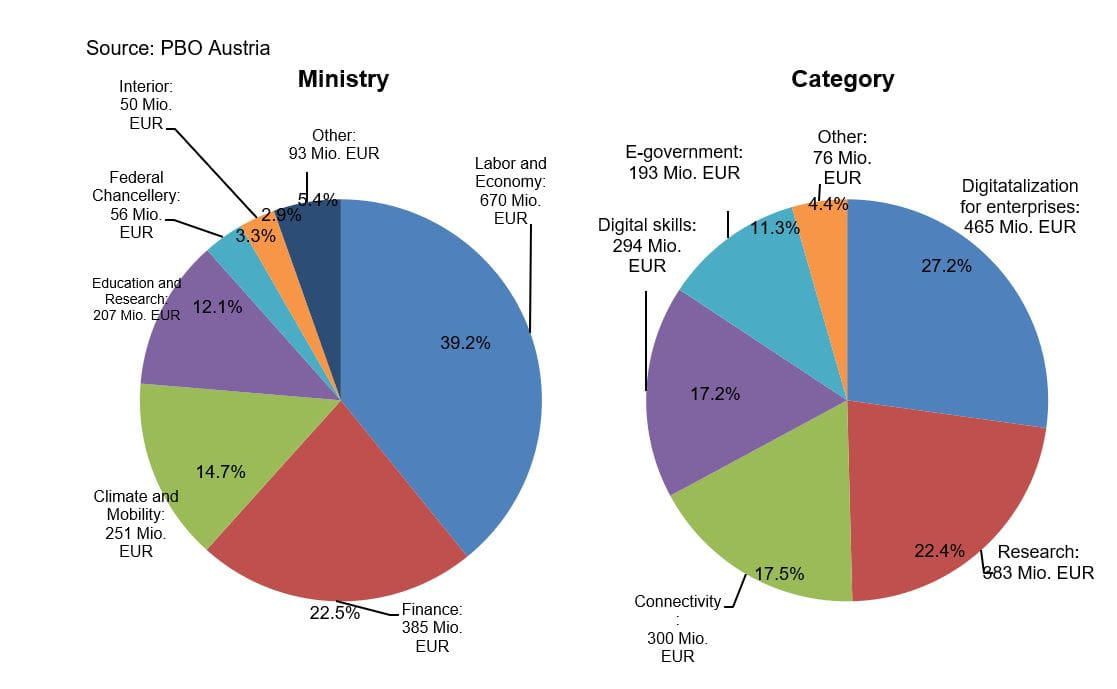Austrian Members of Parliament (MPs) have observed a lack of transparency of resources budgeted for digitalization. This prompted a request to the Parliamentary Budget Office to assess the transparency of Austria’s budget and other public documents and give an overview about resources for digitalization. One MP argued that “in the area of digitalization we (‘the Research and Digitalization Committee’) know a lot about the challenges in our society but we still struggle to know how our budget contributes to close the gaps”. The study has been published: https://www.parlament.gv.at/fachinfos/budgetdienst/Budgetmittel-fuer-Digitalisierung
A starting point for the study was an analysis of publicly available documents. While the government has published several strategies over the last ten years covering many different topics, the information is still fragmented. These strategies are often not linked to each other, neither costed nor comprehensive, and are largely politically motivated.
The budget contains a lot of information about digitalization projects, however, but lacks a systematic and strategically oriented presentation. Digitalization activities and projects are normally integrated into the different global budgets but information of digitalization activities and projects is difficult to disentangle from Austria’s standard programmatic, organizational and econiomic classifications of the budget. Often only line ministries have the relevant information. The ceilings of the government’s medium-term budget framework are approved at a highly aggregated level and lacks information on digitalization projects. Though the strategy report (explanatory report of the medium-term budget framework) often refers to digitalization challenges and activities in very general terms, concrete budget information is rare. The budget includes no information on total spending by the government on digitalization initiatives and projects..
The Austrian financial management information system (FMIS) uses a tagging mechanism for IT expenditure mainly covering hardware, software, and IT services. While this tagging helps identifying digitalization expenses in a very narrow sense, the PBO study takes a broader approach that includes, for example, spending on labor market support for digital jobs, school and university courses to develop IT skills, or subsidies for expanding broadband services.
In total the Austrian budget 2023 included roughly 2.4 billion EUR of spending for digitalization. This included 0.6 billion EUR for developing IT infrastructure in the line ministries and 1.7 billion EUR for specific digitalization projects and activities. The study revealed that approximately one-third of expenditure on digitalization in the 2023 budget was tagged as IT related and spending, and around one-sixth represented expenditure of the European Recovery and Resilience Facility with a specific tag. In addition, an analysis of digital activities of all government programs identified additional projects not tagged.
The charts below provide a breakdown of spending on digitalization. The biggest spenders are the Ministry of Labor and Economy (0.7 billion EUR) which provides subsidies for enterprises, labor market support and research projects with a digital focus and the Ministry of Finance which coordinates the government’s digitalization activities and manages a major budget for broadband expansion. Around 25 % of total resources represent subsidies for enterprises to support digitalization, research amounts to 21 % and connectivity as well as building digital competences each account for around 16 %.
Spending for digitalization projects and activities by category and ministry
The following recommendations for action can be drawn from the study:
- First, we observed that the PFM system generates a lot of useful information about resources for digitalization but these data are fragmented and lack a strategic perspective. The study recommends that the government strengthens its existing budget processes by providing strategic guidance for digitalization in the budget circular and coordinating the budgeting activities between the line ministries.
- Second, the multiple strategies provide high-level guidance for the selection of digitalization activities. Given the partly political nature of some documents they are often not specific in terms of budget and timing. Linking these strategies with the budget can close the operational gap and provide a more specific plan and budget breakdown of the digitalization activities.
- Third, resources for digitalization are often part of a broader allocation which poses the risk that the funds budgeted for digitalization are reallocated to other spending items, if not earmarked. This highlights the importance of transparency and scrutiny in both, budget preparation and execution.
- Fourth, the results of this study can inform the design of a budget statement for digitalization summarizing budget information on digitalization as well as an annual report covering the achievements in the digital transformation and implementation of the projects.
Johann Seiwald is an International Consultant for PFM who co-led this study on behalf of the Austrian Parliamentary Budget Office with Petra Gschiel who is a Senior Budget Expert at the Austrian Parliamentary Budget Office.







